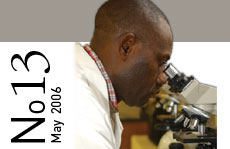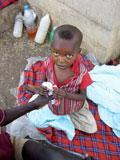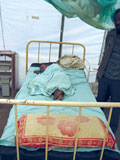 | |

Tackling the critical question
of drug regulation
of drug regulation
Peter Folb
Medical Research Council
South Africa
Medical Research Council
South Africa
 At the heart of drug discovery and development lie drug regulation and drug regulatory authorities. The responsibility of the national regulatory authority (NRA) is to ensure the efficacy, safety, and quality of medicines available to the public. If the NRA is to secure the respect and confidence of the public, government, and drug developers its work should be conducted with ability, integrity, and openness, in a spirit of working for improved public health. Many countries meet these requirements, some with distinction; others do not. Some countries either have no national authority or discharge only the most rudimentary functions due to lack of adequate resources.
At the heart of drug discovery and development lie drug regulation and drug regulatory authorities. The responsibility of the national regulatory authority (NRA) is to ensure the efficacy, safety, and quality of medicines available to the public. If the NRA is to secure the respect and confidence of the public, government, and drug developers its work should be conducted with ability, integrity, and openness, in a spirit of working for improved public health. Many countries meet these requirements, some with distinction; others do not. Some countries either have no national authority or discharge only the most rudimentary functions due to lack of adequate resources. The paradigm of drug regulation, traditionally conducted between the multinational pharmaceutical industry and NRAs, has become blurred in recent times with the introduction of new players. The World Health Organization prequalification process for evaluation of medicines prior to procurement by UN agencies, and the intervention in drug discovery and development by not-for-profit organisations such as DNDi and others, have contributed to that situation. In addressing the present dearth of drugs for neglected diseases, these organisations might need to deal with NRAs thatpossibly lack experience or insight into diseases such as leishmaniasis, trypanosomiasis, or even malaria.
The paradigm of drug regulation, traditionally conducted between the multinational pharmaceutical industry and NRAs, has become blurred in recent times with the introduction of new players. The World Health Organization prequalification process for evaluation of medicines prior to procurement by UN agencies, and the intervention in drug discovery and development by not-for-profit organisations such as DNDi and others, have contributed to that situation. In addressing the present dearth of drugs for neglected diseases, these organisations might need to deal with NRAs thatpossibly lack experience or insight into diseases such as leishmaniasis, trypanosomiasis, or even malaria. Into this uncertainty has marched the ICH process1, an initiative launched in the early 1990s that remains active today. The ICH’s considerable achievements include producing guidelines for evaluation and approval of new medicines that are consistent between countries and scientifically sound. The basis for drug regulation has been strengthened, and industry better protected from arbitrary decision-making by NRAs. But this has brought about a paradox – despite rising standards and consistency, staffing, resources, meetings, and meetings about meetings, the NRAs fall short of what is expected of them, and the public is losing confidence. Agencies are working in relative isolation of each other, rigidly adhering to guidelines and regulations, in expanding bureaucracies, and are increasingly demanding defensive research in their preoccupation with safety and litigation. There is a lack of clinical application in their decision-taking and reluctance to make pragmatic clinical decisions. This has begun to undermine rapid and efficient development of critically-needed and affordable new medicines.
Into this uncertainty has marched the ICH process1, an initiative launched in the early 1990s that remains active today. The ICH’s considerable achievements include producing guidelines for evaluation and approval of new medicines that are consistent between countries and scientifically sound. The basis for drug regulation has been strengthened, and industry better protected from arbitrary decision-making by NRAs. But this has brought about a paradox – despite rising standards and consistency, staffing, resources, meetings, and meetings about meetings, the NRAs fall short of what is expected of them, and the public is losing confidence. Agencies are working in relative isolation of each other, rigidly adhering to guidelines and regulations, in expanding bureaucracies, and are increasingly demanding defensive research in their preoccupation with safety and litigation. There is a lack of clinical application in their decision-taking and reluctance to make pragmatic clinical decisions. This has begun to undermine rapid and efficient development of critically-needed and affordable new medicines.What might be done to address the situation
1. Set standards that are essential for sound medicines, taking into account a global risk-benefit perspective in relation to the needs of patients.
2. Do not allow unrealistic, expensive, and unnecessary defensive research.
3. Arrange early dialogue meetings with NRAs, at which applicants describe their plans for development and testing of their drugs with expert knowledge, authority, understanding, and strategy, to be repeated if necessary later in the development process.
4. Strengthen the WHO prequalification system.
5. Set strict limits on the claims and indications for new drugs, confined to the essential purpose for which they are developed.
6. Encourage a regional approach to evaluation of critically needed new medicines so that expertise and administrative load in the review process might be shared and expedited, and systems put in place for post-marketing surveillance so that the best standards for safety review are assured even after registration approval.
These actions, taken together, would help address the weaknesses in the present system and the isolation in which NRAs currently make their decisions.
It is not being proposed that standards should be lowered. On the contrary, the idea is to raise them in a manner that will make it possible for altruistic and competent organisations to discover and develop new drugs for neglected diseases that no-one else dares (or cares) to do.
1 This refers to the International Conference on the Harmonization of Technical Requirements of Pharma-ceuticals for Human Use. It is an initiative spearheaded by the international pharmaceutical industry and the national drug regulatory authorities of the US, Europe, and Japan, with the WHO and other countries having (and accepting) observer status.
The Rotavirus Vaccine Story
In 1999, a new vaccine against rotavirus was taken off the market in the US due to a small number of adverse effects (approximately 20 cases out of half a million children vaccinated). Rotavirus infections cause 3 million cases annually in the US, but only around 100 deaths in children. Given the small chance of death, it was considered that the vaccine-related increase in occurrence of intussusception (a potentially life-threatening bowel obstruction) was an unacceptable risk to the population. So the vaccine did not make it to the market and a million children died every year due to the lack of a vaccine. Philippe Kourilsky, Le Monde, 07.02.04, "L'éthique du Nord sacrifie les malades du Sud" (trs). Today, a new rotavirus vaccine, Rotateq, made by Merck is at last available for patients in the US (FDA approval 3 February 2006). At $187.50 for three oral doses, this is one of the most expensive vaccines sold, unaffordable by the rest of the world, where children continue to die.
In 1999, a new vaccine against rotavirus was taken off the market in the US due to a small number of adverse effects (approximately 20 cases out of half a million children vaccinated). Rotavirus infections cause 3 million cases annually in the US, but only around 100 deaths in children. Given the small chance of death, it was considered that the vaccine-related increase in occurrence of intussusception (a potentially life-threatening bowel obstruction) was an unacceptable risk to the population. So the vaccine did not make it to the market and a million children died every year due to the lack of a vaccine. Philippe Kourilsky, Le Monde, 07.02.04, "L'éthique du Nord sacrifie les malades du Sud" (trs). Today, a new rotavirus vaccine, Rotateq, made by Merck is at last available for patients in the US (FDA approval 3 February 2006). At $187.50 for three oral doses, this is one of the most expensive vaccines sold, unaffordable by the rest of the world, where children continue to die.
Published by Drugs for Neglected Diseases Initiative - 1 Place St Gervais 1201 Geneva Switzerland
Editor: Jaya Banerji - Tel: +41 22 906 9230 - Fax: +41 22 906 9231 - www.dndi.org
Editor: Jaya Banerji - Tel: +41 22 906 9230 - Fax: +41 22 906 9231 - www.dndi.org